A hot dinner at the end of a cold day on the water is a welcome reward. It’s all the more appreciated at camp or aboard a boat without a heated cabin, but there’s often no time to savor the meal before it gets cold. If dining attire calls for a cap and jacket, your cookpot could probably use something to keep it warm, too: a cozy.
It’s easy to make a cozy to fit almost any camp-cooking pot. The insulation is provided by Reflectix, a double-reflective, double-bubble insulation made for use in construction to provide thermal insulation for everything from water heaters to walls. Its silvery metalized polyester outer layers reflect heat and the two layers of polyethylene bubbles provide dead air space for insulation. The bubbles can’t be popped like those in bubble wrap can. I can stand on Reflectix with all my weight on one heel and not pop a single bubble.
The tape used to put a cozy together is aluminum film with an aggressive rubbery adhesive on one side, which is protected by a peel-off layer of treated paper.
Here’s how to make a camp-cookpot cozy:
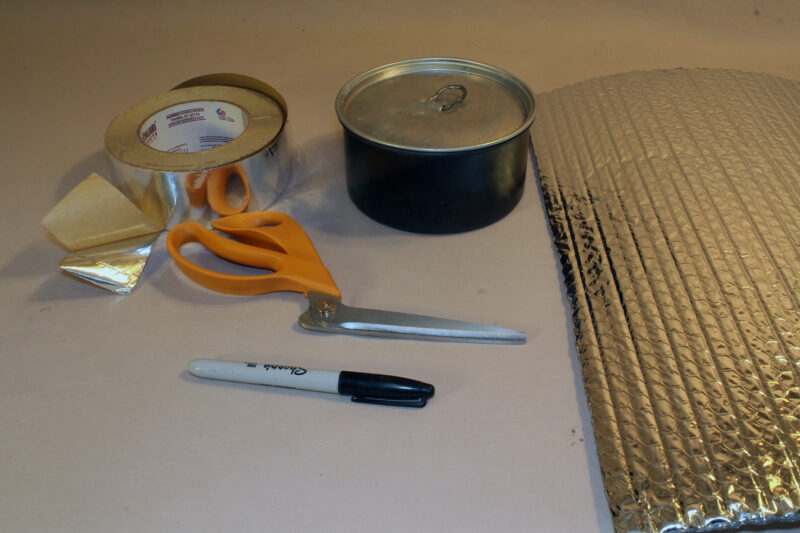 Photographs by the author
Photographs by the authorAll that’s required for the project are aluminum foil tape, scissors, a Sharpie marker, some Reflectix, and a pot with a lid.
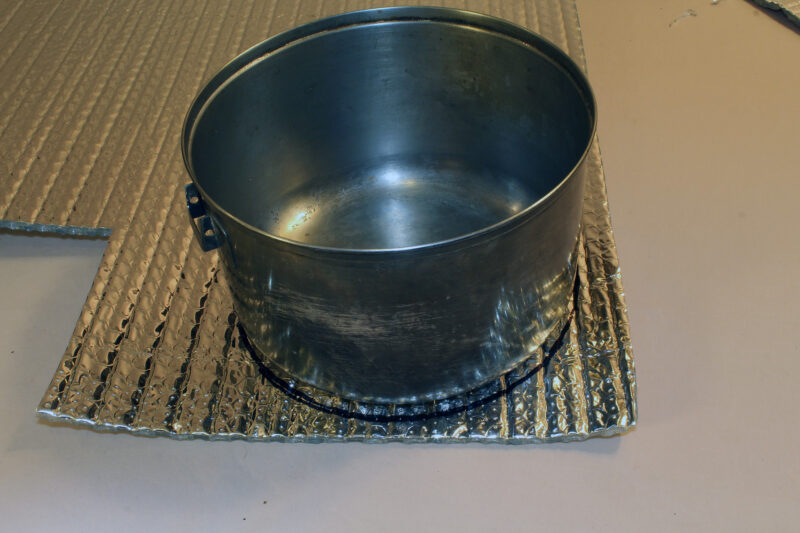
Trace around the bottom of the pot. Sight down the side of the pot and hold the Sharpie to mark a circle that is the same size as one that would be traced around the outside of the pot’s side. Cut along the outside of the Sharpie line to make the disk of Reflectix a bit oversized. Note that the bubbles on the edges of a roll of Reflectix are deflated to create a margin that can be stapled to wall studs prior to the installation of drywall.
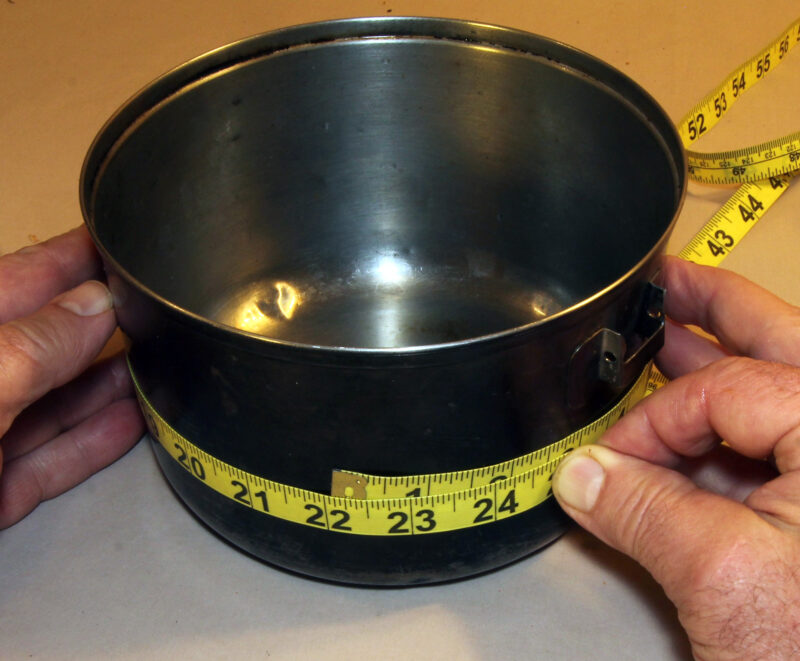
Measure the circumference around the side of the pot. Then measure the height of the side from its bottom to where the side flares to meet the rim. Cut a piece of Reflectix that is about 1″ longer than the circumference measurement and 1⁄4″ wider than the height measurement. The rows of bubbles evident on the Reflectix should run perpendicular to the length of the piece to be cut for the side of the cozy.
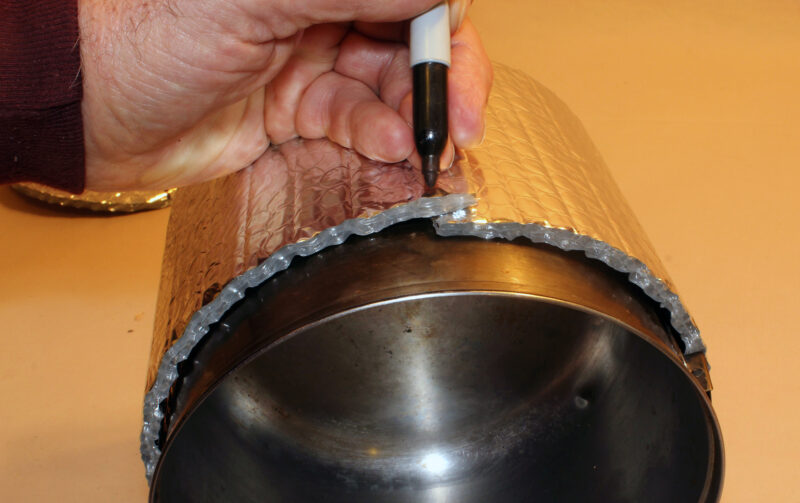
Wrap the cozy side around the pot, keeping it below the pot rim, and mark the point of overlap. Trim the end of the side to that mark. This should provide a slip fit for the cozy.
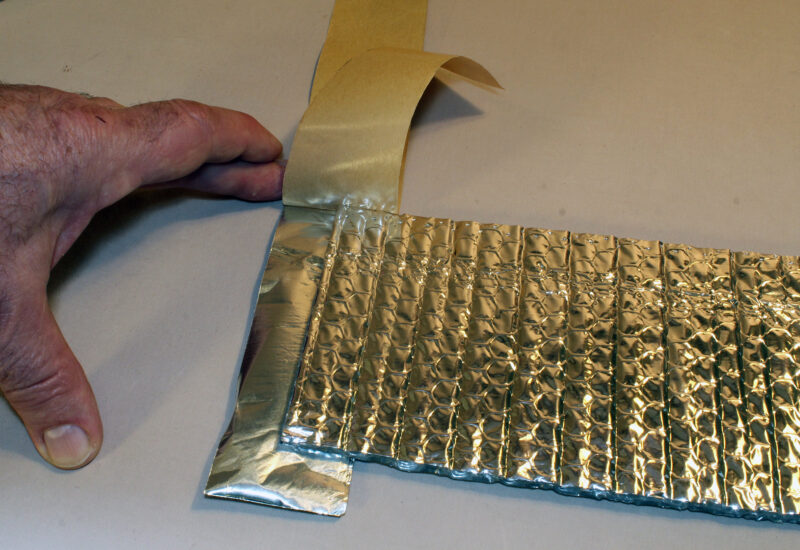
Cut a piece of aluminum tape that is 2″ longer than the cozy side is wide. Peel the tape backing halfway back and set the side on the tape, covering half of the tape. Locate the Reflectix carefully: the tape grabs quickly and firmly but it can be peeled off with a bit of care and effort if you need to reposition it.
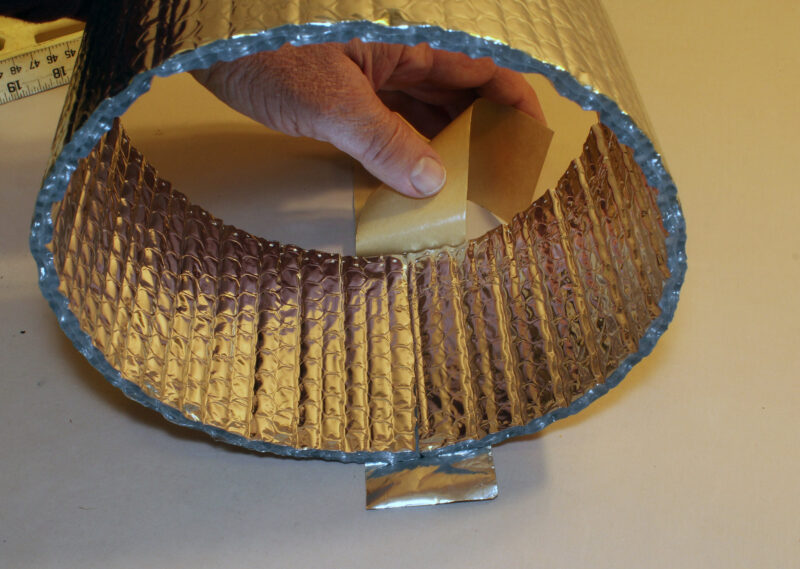
Loop the cozy side over the tape and butt its ends together. Press them to the tape.
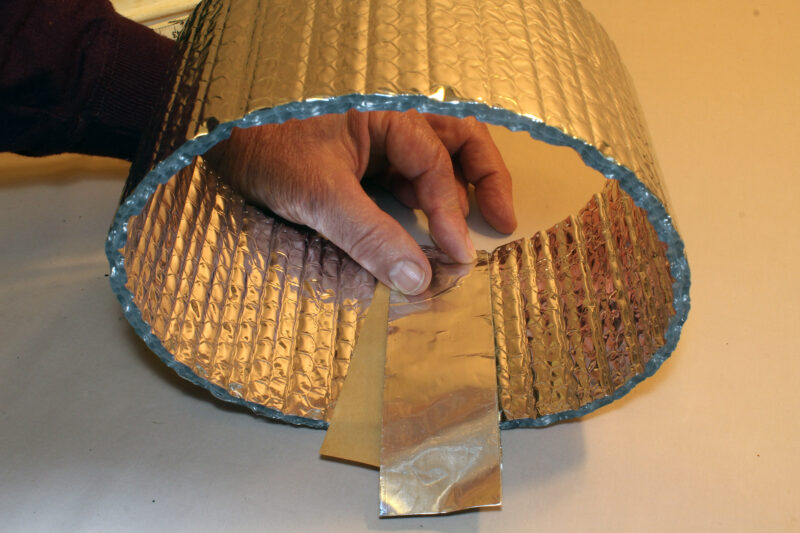
Put the far end of the tape through the loop.
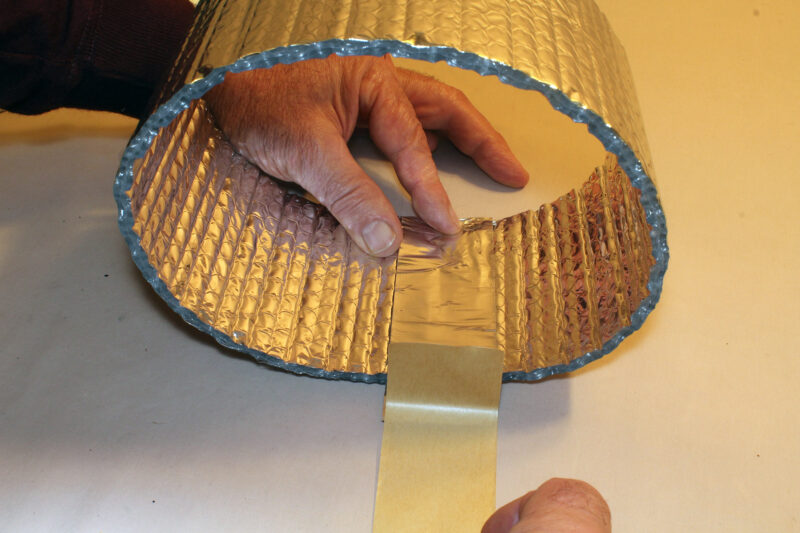
Set the tape over the seam and pull the tape backing through and off.
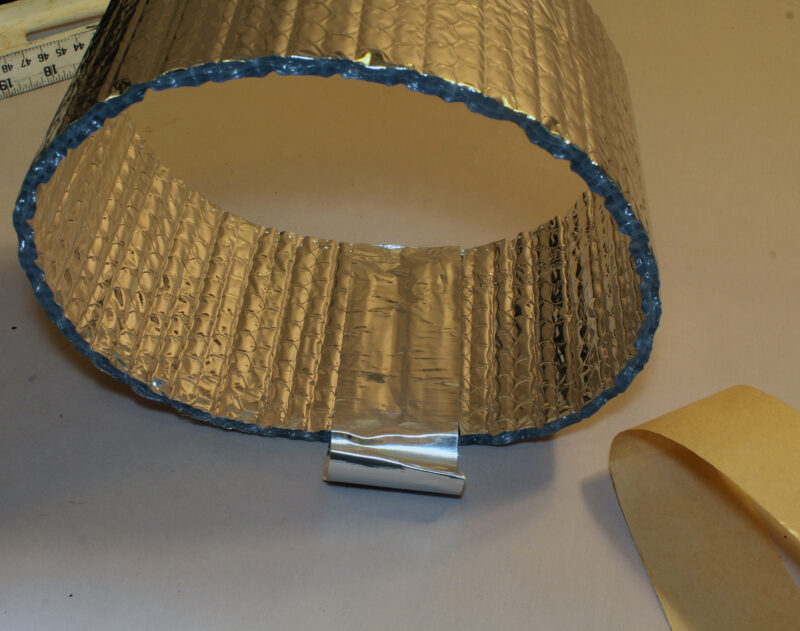
Trim the excess tape.
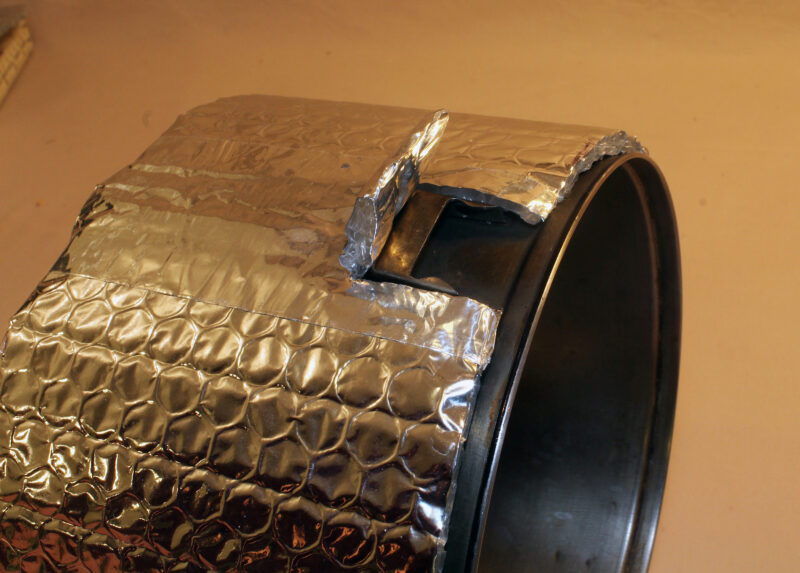
Slip the cozy side on the pot and make any slits that are needed to accommodate handles. The pot will be moved from the stove while hot, and the handles need to slip into the cozy. The handles can then be folded or remain deployed. In some cases, the flap created by the slits can remain connected to be laid back against the pot to insulate it.

Slip the cozy side on the pot, butting it against the flared rim. The cozy bottom will fit inside the cozy side.
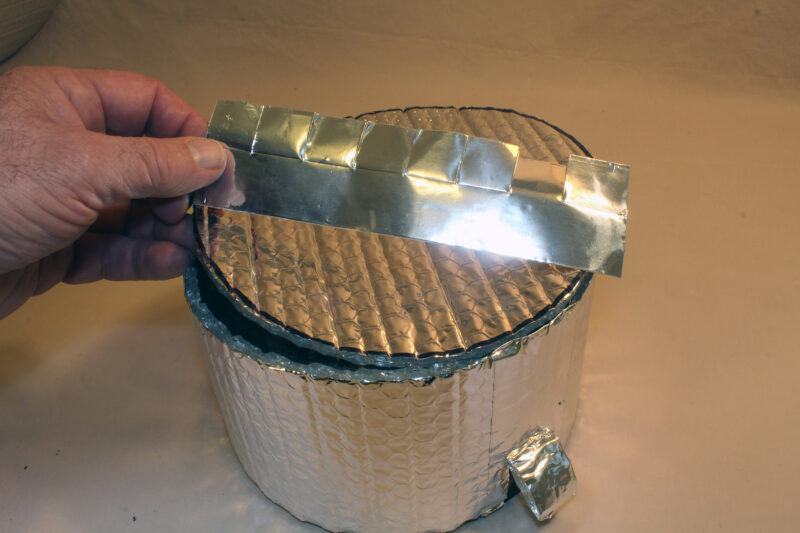
It’s easiest to tape the bottom and side together in a few sections. Cut the tape in pieces 4″ to 6″ long and cut slits, about 3⁄4″ apart, from one side to the middle of the tape.
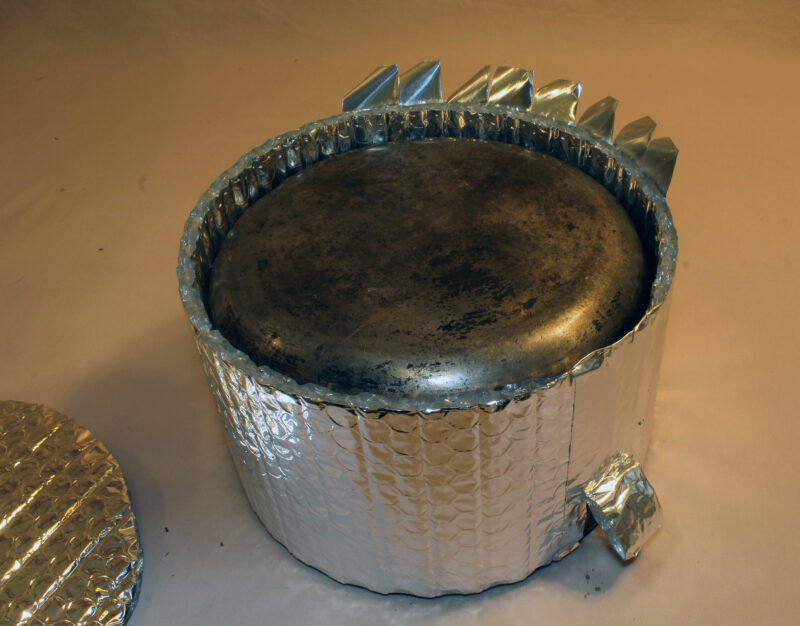
Peel the backing off, starting at the side without the slits. Apply the tape to the side of the cozy with the tabs up.
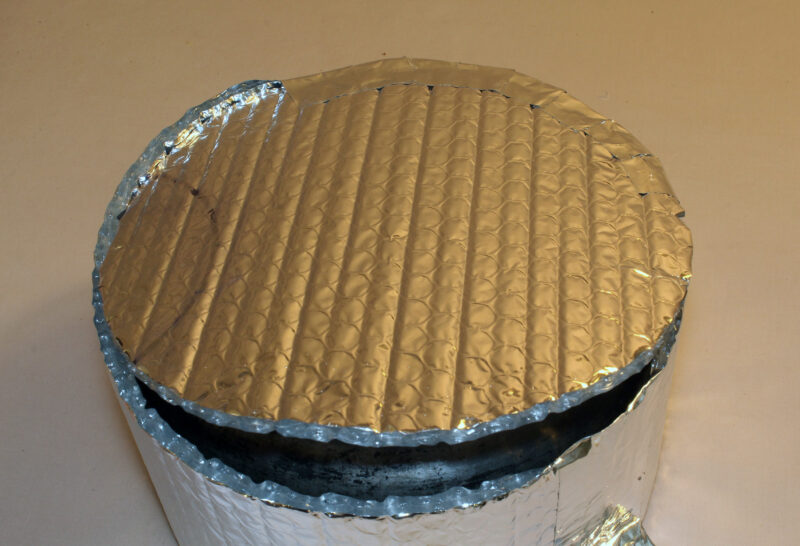
Fold the tabs over, pulling them tight to press the cozy side tight to the bottom.
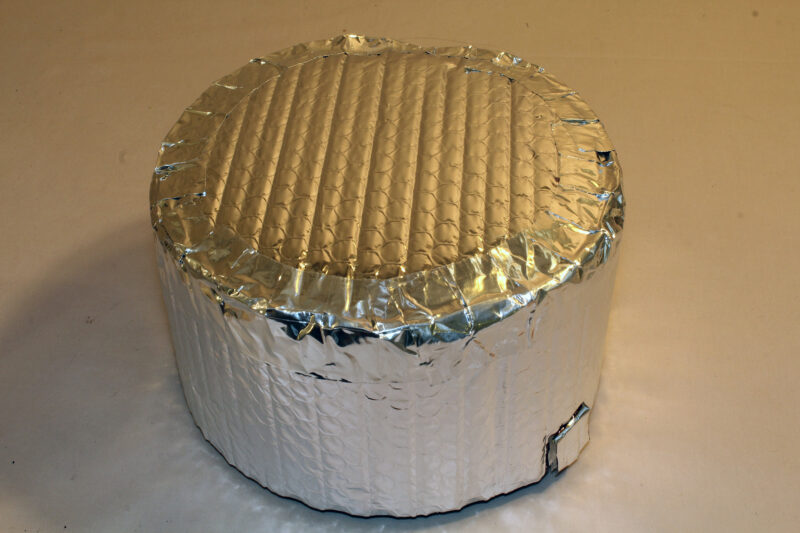
When the entire perimeter has been taped press the tape tight to the Reflectix.
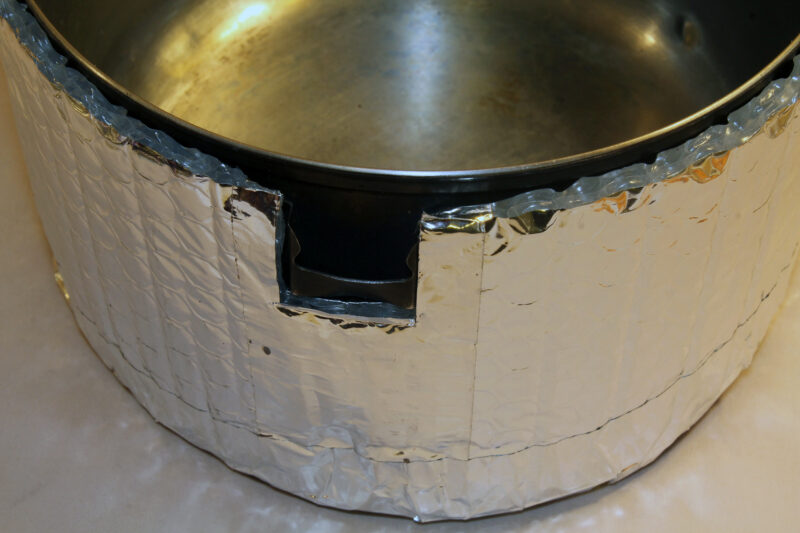
For this pot, the flaps could not be folded over the handle fittings, so I cut them off. The missing insulation will be covered by the cozy’s lid.

Put the pot and cozy upside down on a piece of Reflectix and trace a circle. As before, sight down the side of the cozy and angle the Sharpie to draw its line to the outside of the cozy side.
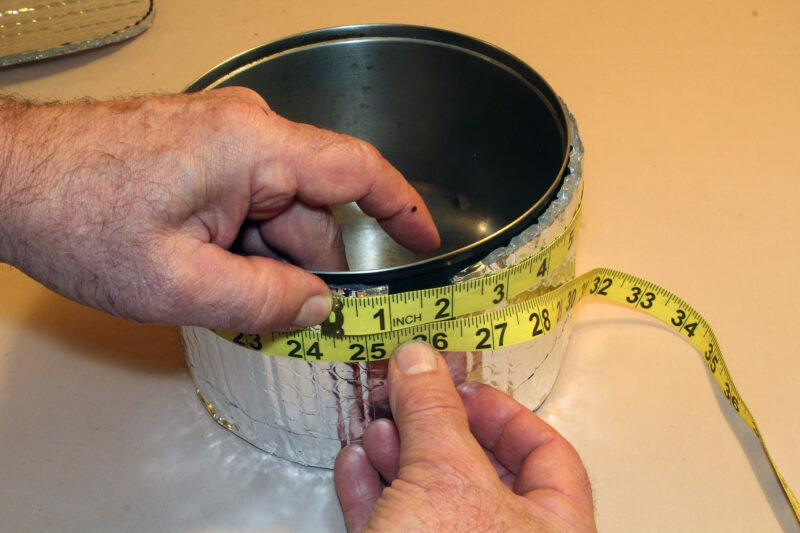
For the side of the cozy lid, measure around the cozy side. Add 1″ to that dimension for the length of the lid side. The width is not critical. For this pot I chose 3″, more than enough to cover the pot’s handle fittings.
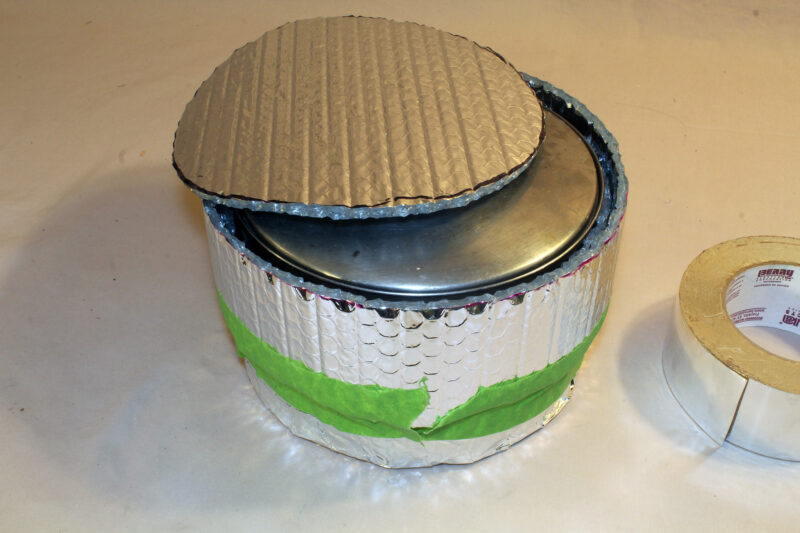
Tape the ends of the lid’s side together as before and slip the ring formed over the pot, lid, and cozy bottom. Use masking tape to hold the lid side in place with its top edge 1⁄4″ above the pot lid. Tape the lid in place using sections of aluminum tape with tabs cut on one side.
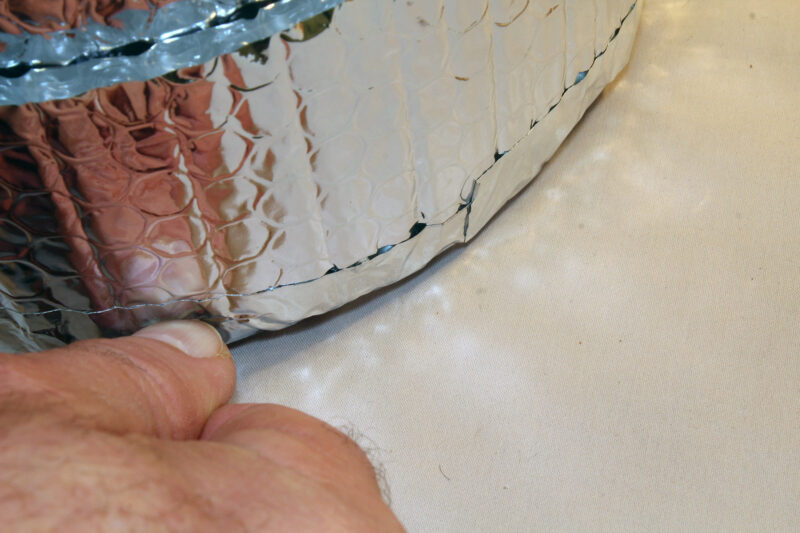
Check all tape edges and press them tight wherever there are gaps.
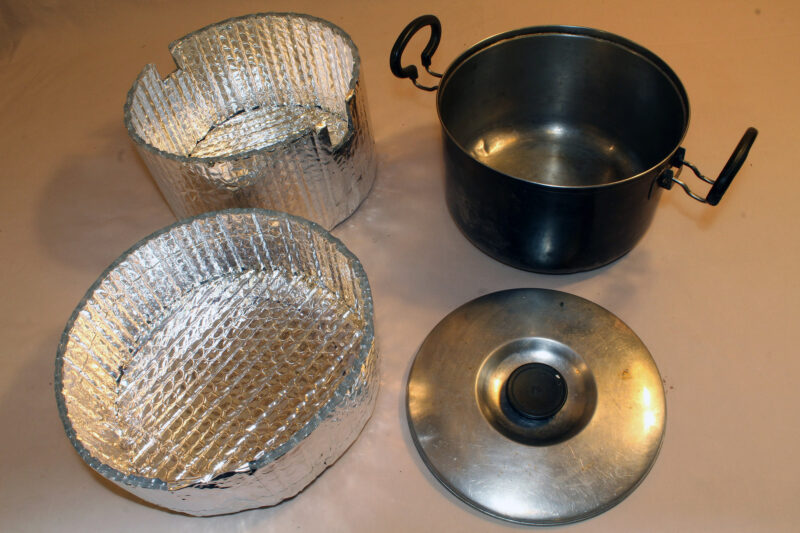
The finished cozy is ready for use.
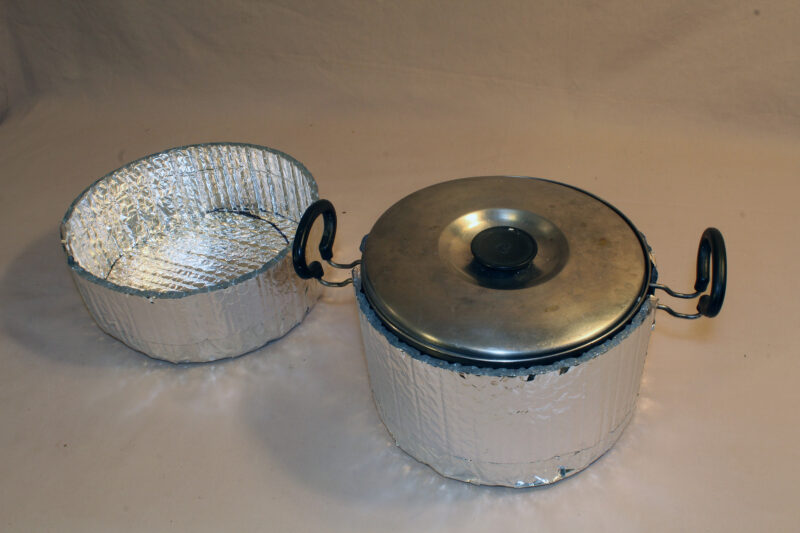
The pot should slip into the bottom of the cozy with the handles in place.
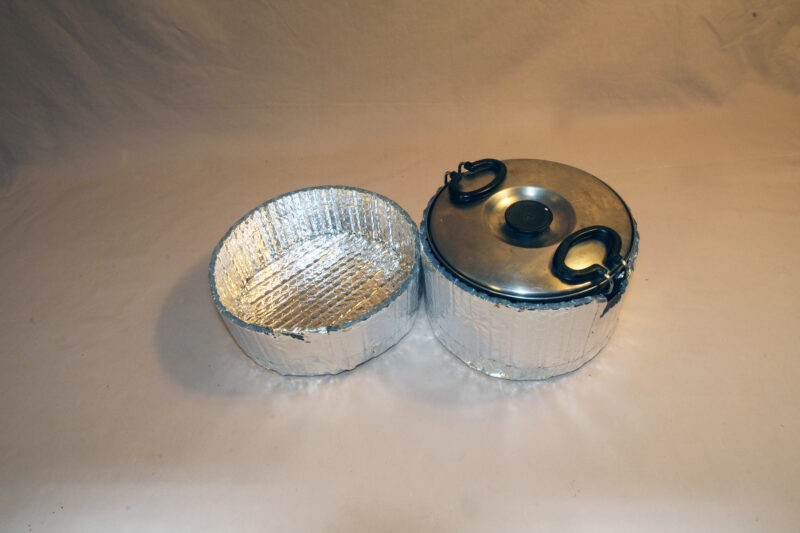
After the handles are folded, the pot is ready for the cozy lid.
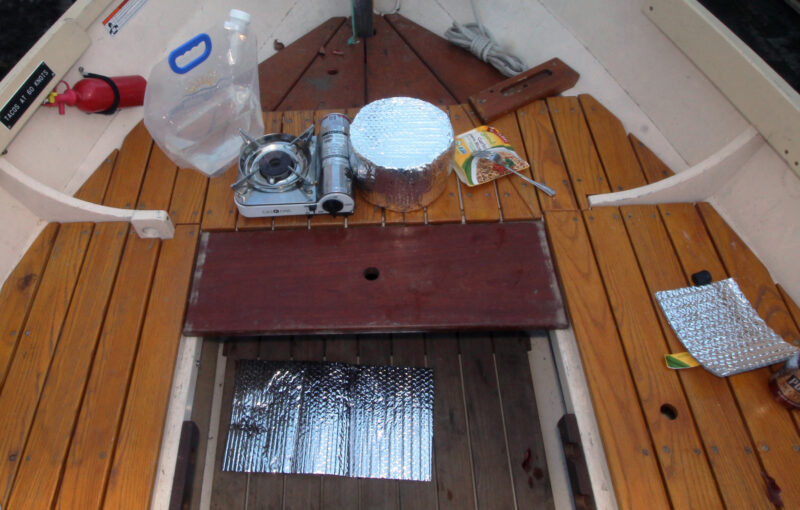
With a hot meal inside the pot, the cozy holds the heat in. A small piece of Reflectix, to right, protects the varnish on the boat’s seats. The larger piece of Reflectix serves as a pad for kneeling at the galley.
Reflectix is designed to be used in environments as hot as 180 degrees F. A pot of water heated to a rolling boil and removed from the stove can be immediately set on Reflectix without damaging it but a cookpot heated to the point of making olive oil smoke will melt the material and leave some adhered to the pot. For the higher temperatures of frying, I’d recommend cooking in a fry pan and transferring the finished dish to the cookpot nestled in its cozy.
Meals can be eaten directly and immediately from the cookpot—the cozy makes it possible to hold it. The cozy will also keep food hot between servings. After I’d had a bowlful of seasoned instant rice, I put the lid on the pot and slipped it into the cozy. After 20 minutes in 55-degree temperatures, the rice was still pleasantly hot, about 122 degrees F.
Reflectix can also be used to insulate Nalgene bottles to keep ice water cold in the summer, serve as a windshield sun guard, and provide warm, cushioned seat pads.![]()
Reflectix and aluminum tape can be purchased from hardware stores and online retailers. Small rolls of Reflectix and tape are available. AntiGravityGear offers kits for making single cozies. A similar-looking product carried by Home Depot under the Everbilt brand is only half as thick as Reflectix. It comes at about half the price but I recommend against using it.
Christopher Cunningham is the editor of Small Boats.
You can share your tips and tricks of the trade with other Small Boats Magazine readers by sending us an email.

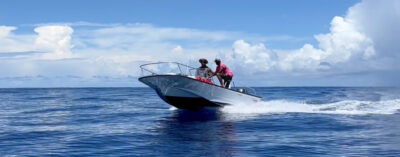
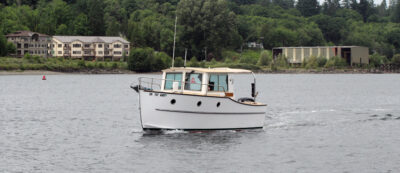
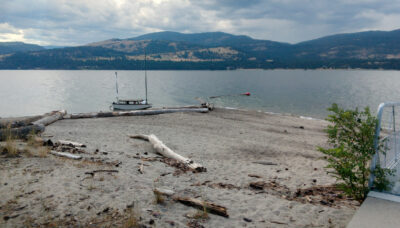
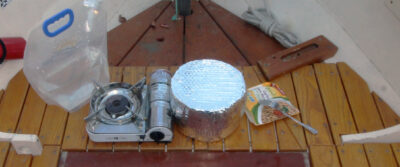
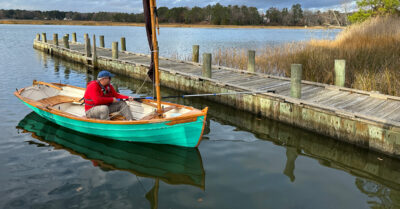
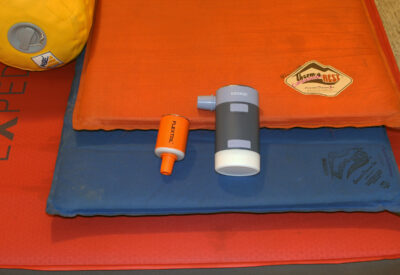

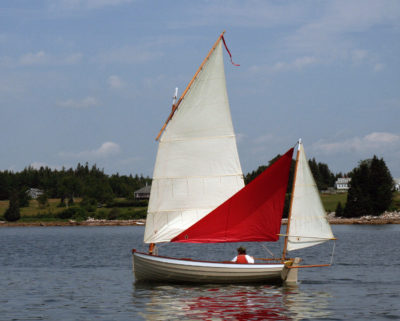
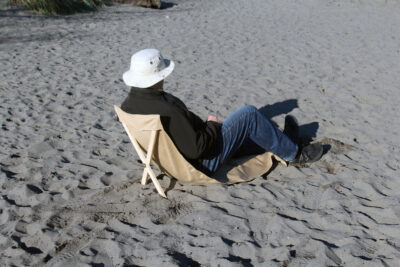

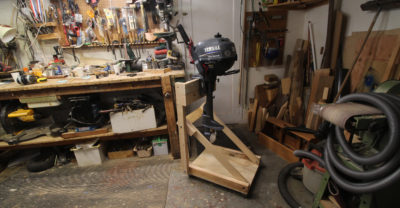
Nicely done!
I have used these cozies on my titanium, press-pot, coffee pot for years. I can leave coffee in the pot and the insulation lets it double as a short-term thermos. I always used Gorilla Tape for the seams, but from now on I’m switching to the aluminum tape. Great article!
Cozies like this or similar can, in addition to keeping already cooked food hot, be used to save stove fuel. I use them when cooking foods like porridge (my standard breakfast) or pasta. Typically, bringing the water and porridge or pasta to a boil plus a few minutes more, then shutting off the stove, putting the pot in the cozy and letting the retained heat do the rest, will be sufficient. It takes a little experimentation to find the right combination of boiling and sitting time.
I have found it saves about half the fuel, which is not insignificant on a long wilderness trip in the kayak or sail-and-oar boat.
A point worth considering is the lifespan of this material and what happens as it weathers, and breaks down. Like poly tarps and what not littering micro plastics. A suggestion would be fabric coverings for longevity and containment.